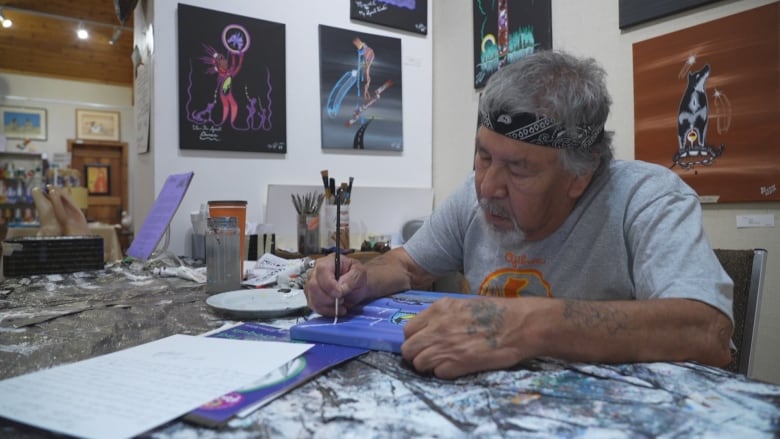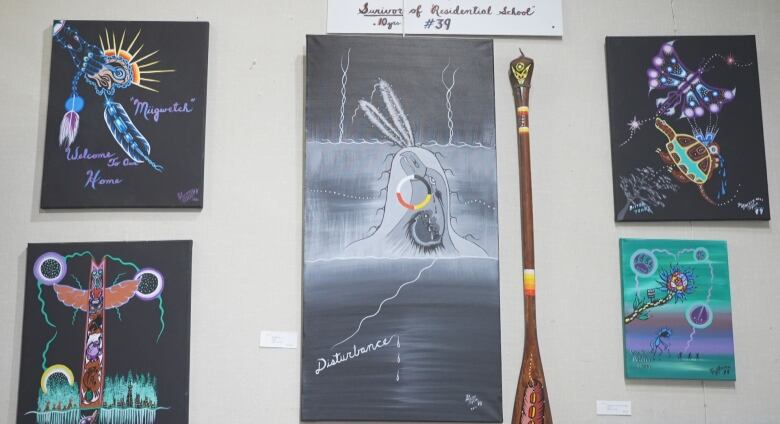Indigenous artist uses painting to heal from residential school trauma
'I just let my Creator guide me,' Freddy Taylor, 76, says of his colourful artwork

WARNING: This story contains details readers may find distressing.
For Indigenous artist Freddy Taylor, 76, painting has brought purpose back into his life, giving him a way to heal from the trauma he experienced as a child while attending an Indian residential school in Ontario for 10 years.
"I don't know how I do it, but the gift that the Creator has given me, you'll never see a pencil mark on my work. I never use a pencil," Taylor says.
"I just let my Creator guide me and itcomes out with all these. See, there'sthe Wolf, the Bear, the Creator, the Bird Peopleand the Turtle.Here's the Eagle with the four directions.This is the Red man, the Black man, the Yellow man, and the White man."
Taylor, anOjibwe man originally from Curve Lake, attended the former Mohawk Institute Residential Schoolin Brantford, Ont. While he was there, he lost his language and he lost his culture. He was given a number and he forgot his name. His hair was cut short.For 10 years, he never saw his parentsand he never saw Curve Lake, which is north of Peterborough. The schoolclosed in 1970.
"They tore the insides of me out," he says of the residential school.
Taylorwas sexually abused at the Mohawk Institute and beaten for telling the school principal that he was violated. The experience hardened him. Years would pass, including time in prison,before he would be able to heal. Now he says he's in the "healing world."

Over 150,000 Indigenous children removed from families
Last week, the Ontario government announced that it is earmarking $10 million in funding over a three-year span to identify, investigate and commemorate residential school burial sites in Ontario.
The province said the funding will also ensure that culturally appropriate, trauma-informed mental health supports are available for Indian residential school survivors, their families and Indigenous communities.
In Canada, more than150,000 Indigenous children were forcibly removed from their families and communities and sent to residential schoolsbetween 1870 and 1996. According to the Truth and Reconciliation Commission (TRC), there were 18 residential schoolsin Ontario.The last of these closed in 1991.
Mark Hill, elected chief of the Six Nations of the Grand River,has written an open letter to Prime Minister Justin Trudeau calling for the federal government to equip the Six Nationsto conduct a search for missing children on and around the grounds of the former Mohawk Institute.
The TRCestimated that at least 426 children who attended residential schools in Ontario are known to have died, while an unknown number are still missing.The TRC research has identified 12 locations of unmarked burial sites in Ontario, but there are likely more, officials say.
Discovery of remains brings back painful memories
Asked about the recent discovery of remains of 215 children at a former residential school in Kamloops, B.C., Taylor says when he heard the news, he immediatelythought about the pain of theparents whose children were ripped from their families and communitiesby the Canadian government and Christian churches.
"I could feel my parents crying.They must've missed me, my other sisters," he says.
"If all the survivors in the country was given a piece of land and a house to build on, survivors alone, we'd be one happy reserve."
And he remembered he was told never to go near the orchard at the Mohawk Institute. "There's graves under those apple trees, and there's graves around the Mohawk chapel," he says.

Strangers took Taylor, 3 older sisters to residential school
Taylor said his earliest memory of the school is from the age of five. He and his three older sisters were taken to a schoolhouse by strangers, given a bath and a change of clothes. Then they were taken to the residential school itself, put in a little room, and told the four of them would visit with each other once a week. He would seldom see his sisters again. He was given a number 39 and his hair was cut.
"The residential school is like a school for convicts. It gets you ready for the prison system," he said.
Taylor said he remembers the meals becauseall the survivors of Mohawk Institute did. The school was called the Mush Hole for the unsweetened porridge they ate, served with powdered milk. The children were often hungry. Taylor saidolder boys often forced the younger ones to save food for them.
"About the third week that I was in the Mush Hole, one of the bigger boys wanted my toast that morning, and I didn't give it to him. I ate it myself. I knew he was waiting for me in the playroom.So here he is, when I get in the corner and there was a staff. And he knew there was going to be something. But instead of him grabbing that bigger boy, he grabbed me by my shoulder and threw me against a beam. And it broke my shoulder and it's still sore today."
WATCH | Indigenous artist Freddy Taylor talks to CBC News about residential school:
Taylor said he learned to fight. As he got older, he too took food from the smaller boys or he left the dorm late at night to scavenge for cake and candy at the town dump. He recallshis sisters leaving food for him in a box.
'It seemed like the devil moved inside of me'
One night, lying in his bed, before he was seven years old,Taylor said aministerled him out of the room. He had seen other boys taken out at night, and always wondered why.
"I tell you when I was sexually abused by this minister, I broke the line at the breakfast table, and I ran up to the principal's office," he says.
Taylortold the man in the office what had happened the night before.The man called the other little boys from the breakfast table to the playroom to watch as Taylorwas stripped down and tied to a bench. He was beaten witha strap that was like horse belt withstuds on it.
Taylor said he remembers waking up in the dispensary. The beating was so remorseless and the injustice so monumental that it changed him. The other childrencould tell and Taylorbecame one of the most dangerous childrenat the school.
"I woke up in the dispensary, all bloody, full of pain and anger," he said.
"When I woke with all those lumps and bruises on my tiny body, it seemed like the devil moved inside of me," he said.
"And I said, this is never going to happen. I'll never ever tell the truth again, no matter what type of beating I get. I'll never tell the truth. I'll lieand cheat and everythingwill be for myself. I'll be greedy. When I got out of that, it took me a month and a half to walk," he added.
"When I got back in the population, the bigger boys knew there was something wrong with me. Because I was mean, I didn't care how big the guy was, I'd bite, scratch, kick, whatever. And I'd win.Sometimes I'd lose I'd get black eyes, my arms would be sore for months. But I fought."

Years later, when he returned to Curve Lake after residential school, he said it was frightening. His parents were drinking and they were speaking a language he couldn't understand. He saidhe felt "like a tumbleweed" but was full of anger, pain, hatred and shame.
And when he became an adult, he ended up committing crimes, including carrying out armed robberies, collecting drug money, breaking into people's houses. But he has found his way back to a purposeful life, with the help of his wife, "a strong, understanding person," and the Creator.
Taylor said the Creator gave him the gift of painting and he includes the meaning of each painting on a piece of paper on the back of each artwork. "My Creator arrives at the end of that brush," he said.
'Painting you pick ... will match whatever path you're on'
Now, Taylor goes to the Whetung Ojibwa Centre in Curve Lake three days a week. Gallery owner Michael Whetung reserves a corner for Taylor's chair and table, where he sits and paints whatever images come to mind onto a freshly painted background.
"Today, when I was painting the background. I felt nice, warm, comfortable. Even though it was a black background, it was starting to getcolourful, thenall of a sudden, bang. I don't know what's going to be in that painting, but it's going to be something bright," he said.

"Oh yeah, I can feel the energy. It's not me, mind you, it's not me. It's the Creator working through me, to reach out to others that can't get a grasp about life, that can't seem to get over their hardships andheartaches and pain. That's who buys my paintings," he added.
"I tell them, I don't pick out paintings for them.Pick what you want, andI can guarantee, the painting you pick and the meanings behind therewill match whatever path you're on."
Monday is National Indigenous Peoples Day.
Support is available for anyone affected by their experience at residential schools and those who are triggered by the latest reports.
A national Indian Residential School Crisis Line has been set up to provide support for former students and those affected. People can access emotional and crisis referral services by calling the 24-hour national crisis line: 1-866-925-4419.
With files from Mary Wiens and Muriel Draaisma













_(720p).jpg)


 OFFICIAL HD MUSIC VIDEO.jpg)
.jpg)



























































































